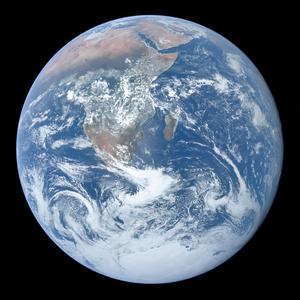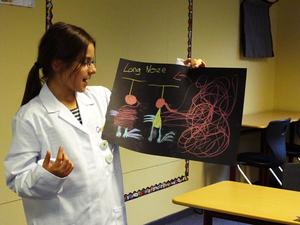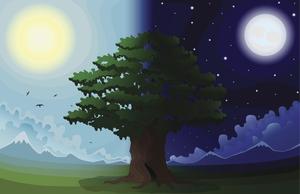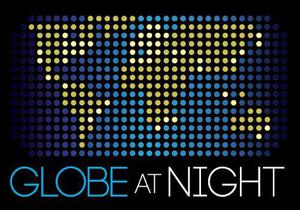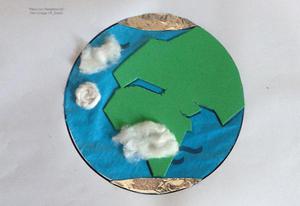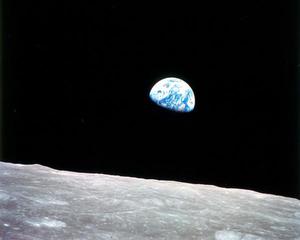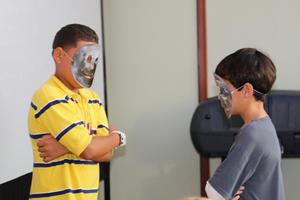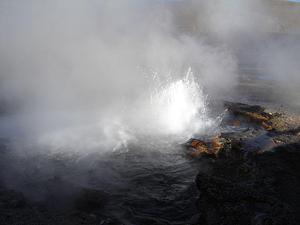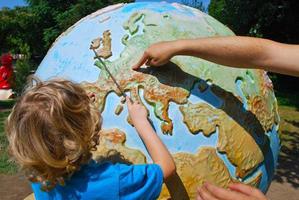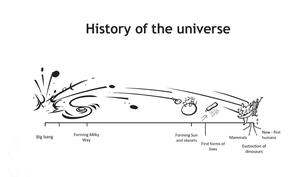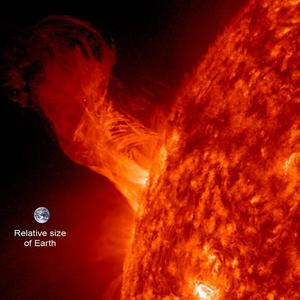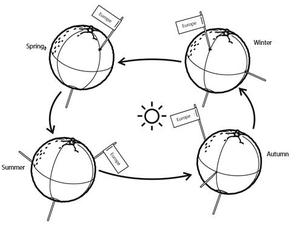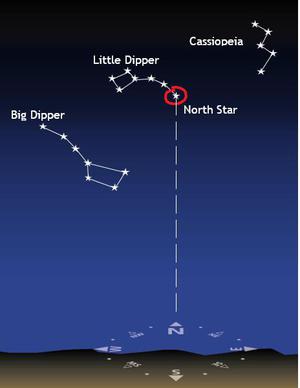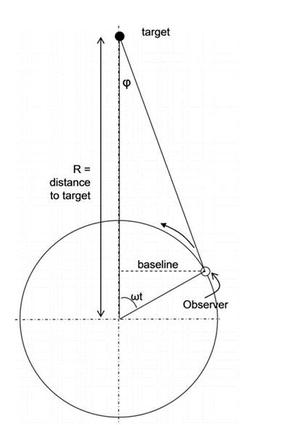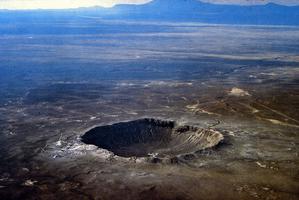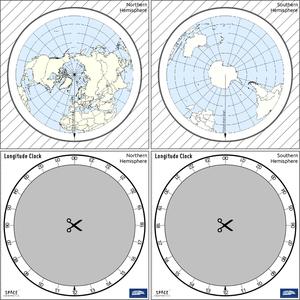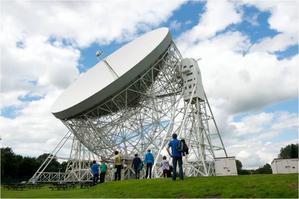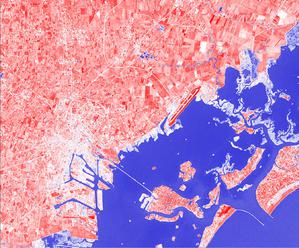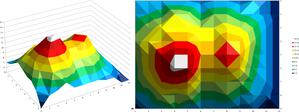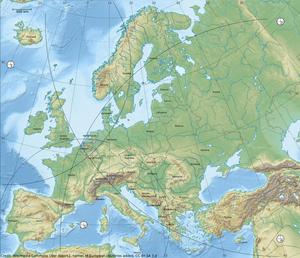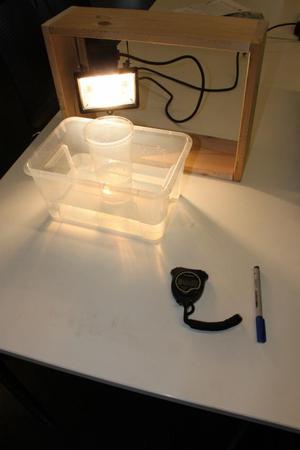Glossary term: पृथ्वी
Description: पृथ्वी हा सूर्यापासून तिसरा ग्रह आहे आणि सूर्यमालेतील पाचवा सर्वात मोठा ग्रह आहे. हा सुमारे ६,४०० किलोमीटर (किमी) त्रिज्या असलेला खडकाळ, पार्थिव ग्रह आहे. त्याचे वस्तुमान सुमारे सहा ट्रिलियन, ट्रिलियन किलोग्रॅम आहे.
सूर्यापासून पृथ्वीचे सामान्य अंतर सुमारे 150 दशलक्ष किलोमीटर आहे. हे एक खगोलशास्त्रीय एकक म्हणून परिभाषित केले आहे. पृथ्वीला सूर्याची कक्षा पूर्ण करण्यासाठी ३६५.२६ वेळ लागतो. पृथ्वीचा एक नैसर्गिक उपग्रह आहे जो चंद्र म्हणून ओळखला जातो.
पृथ्वी ही मानवांसह लाखो सजीव प्रजातींचे घर आहे; विश्वात आजपर्यंतचे हे एकमेव ठिकाण आढळले आहे जेथे जीवन आहे. हे सुमारे 4.54 अब्ज वर्षांपूर्वी तयार झाले असे मानले जाते. पृथ्वीवर वातावरण आणि चुंबकीय क्षेत्र आहे जे हानिकारक किरणोत्सर्ग रोखण्यासाठी कार्य करते आणि म्हणूनच सजीवांच्या जगण्यासाठी अनुकूल आहे. पृथ्वीवरच्या विस्तृत पृष्ठभागावर पाणी आहे (सौरमालेतील एकमेव ग्रह असे असण्यासाठी ज्ञात आहे), ज्यामुळे पृथ्वीला निळा रंग येतो.
Related Terms:
See this term in other languages
Term and definition status: The original definition of this term in English have been approved by a research astronomer and a teacher The translation of this term and its definition is still awaiting approval
The OAE Multilingual Glossary is a project of the IAU Office of Astronomy for Education (OAE) in collaboration with the IAU Office of Astronomy Outreach (OAO). The terms and definitions were chosen, written and reviewed by a collective effort from the OAE, the OAE Centers and Nodes, the OAE National Astronomy Education Coordinators (NAECs) and other volunteers. You can find a full list of credits here. All glossary terms and their definitions are released under a Creative Commons CC BY-4.0 license and should be credited to "IAU OAE".
If you notice a factual or translation error in this glossary term or definition then please get in touch.
Related Media
Earth as observed from Apollo 17
Credit: NASA/Apollo 17 crew/Project Apollo Archive
License: PD Public Domain icons
Related Activities
Design Your Alien
astroEDU educational activity (links to astroEDU website) Description: Design an alien life form suited for an extra-terrestrial world.License: CC-BY-4.0 Creative Commons Attribution 4.0 International (CC BY 4.0) icons
Tags: Life , Environment , Extra-terrestrial , Art , Creativity , Hands-on , Alien Age Ranges: 8-10 , 10-12 Education Level: Primary , SecondaryWhy Do We Have Day and Night?
astroEDU educational activity (links to astroEDU website) Description: Explore day and night of Earth.License: CC-BY-4.0 Creative Commons Attribution 4.0 International (CC BY 4.0) icons
Tags: Tilt Age Ranges: 6-8 , 8-10 , 10-12 Education Level: Primary , Secondary Areas of Learning: Modelling , Structured-inquiry learning , Social Research Costs: Low Cost Duration: 1 hour 30 mins Group Size: Group Skills: Asking questions , Communicating informationGlobe at Night Activity Guide
astroEDU educational activity (links to astroEDU website) Description: Learn to observe and record the faintest visible stars to measure the light pollution.License: CC-BY-4.0 Creative Commons Attribution 4.0 International (CC BY 4.0) icons
Tags: Hands-on , Dark skies , ecology , Citizen science Age Ranges: 4-6 , 6-8 , 8-10 , 10-12 , 12-14 , 14-16 , 16-19 , 19+ Education Level: Informal , Middle School , Other , Primary , Secondary , University Areas of Learning: Observation based , Project-based learning Costs: Low Cost Group Size: Group Skills: Communicating information , Planning and carrying out investigationsMeet Our Home: Planet Earth
astroEDU educational activity (links to astroEDU website) Description: Explore a tactile version of our home, the Earth, with household materials.License: CC-BY-4.0 Creative Commons Attribution 4.0 International (CC BY 4.0) icons
Tags: Hands-on , Model , Visually Impaired , Tactile Age Ranges: 6-8 , 8-10 , 10-12 Education Level: Middle School , Primary , Secondary Areas of Learning: Interactive Lecture , Modelling Costs: Low Cost Duration: 1 hour 30 mins Group Size: Group Skills: Analysing and interpreting data , Asking questions , Communicating information , Developing and using modelsBlue Marble in Empty Space
astroEDU educational activity (links to astroEDU website) Description: Students are taken on a virtual journey to outer space to experience that we live on a tiny planet that floats in a vast and empty space.License: CC-BY-4.0 Creative Commons Attribution 4.0 International (CC BY 4.0) icons
Tags: Life , Hands-on , Model , Scales , Distances , ISS Age Ranges: 6-8 , 8-10 Education Level: Primary , Secondary Areas of Learning: Interactive Lecture , Modelling Costs: Low Cost Duration: 30 mins Group Size: Group Skills: Asking questions , Communicating information , Developing and using modelsLunar Day
astroEDU educational activity (links to astroEDU website) Description: Through a fun-learning activity, understand why moon always keeps the same face towards Earth.License: CC-BY-4.0 Creative Commons Attribution 4.0 International (CC BY 4.0) icons
Tags: Lunar day Age Ranges: 4-6 , 6-8 Education Level: Primary , Secondary Areas of Learning: Modelling , Structured-inquiry learning Costs: Free Duration: 30 mins Group Size: Group Skills: Analysing and interpreting data , Asking questions , Communicating information , Constructing explanations , Developing and using modelsFizzy Balloons – CO2 in School
astroEDU educational activity (links to astroEDU website) Description: Investigate the properties of carbon dioxide with this fun demonstration.License: CC-BY-4.0 Creative Commons Attribution 4.0 International (CC BY 4.0) icons
Tags: Life , Hands-on , Chemistry , Earth Science , Carbon Dioxide Age Ranges: 8-10 , 10-12 Education Level: Primary , Secondary Areas of Learning: Interactive Lecture , Traditional Science Experiment Costs: Medium Cost Duration: 2 hours Group Size: Group Skills: Analysing and interpreting data , Asking questions , Constructing explanations , Engaging in argument from evidence , Planning and carrying out investigationsDay and Night in the World
astroEDU educational activity (links to astroEDU website) Description: Compare diurnal and nocturnal animals and experiment with day and night.License: CC-BY-4.0 Creative Commons Attribution 4.0 International (CC BY 4.0) icons
Tags: Life , Model , Animals , Day and night Age Ranges: 6-8 , 8-10 Education Level: Primary Areas of Learning: Interactive Lecture , Modelling , Social Research Costs: Low Cost Duration: 1 hour Group Size: Group Skills: Asking questions , Constructing explanations , Developing and using models , Planning and carrying out investigationsLet's Map the Earth
astroEDU educational activity (links to astroEDU website) Description: Discover how to read and draw maps by observing.License: CC-BY-4.0 Creative Commons Attribution 4.0 International (CC BY 4.0) icons
Tags: Hands-on , Scales , Geography , Maps , GPS , Coordinates Age Ranges: 8-10 , 10-12 Education Level: Primary Areas of Learning: Modelling , Social Research Costs: Low Cost Duration: 1 hour Group Size: Group Skills: Analysing and interpreting dataHistory of the Universe
astroEDU educational activity (links to astroEDU website) Description: Build a timeline of the all Universe!License: CC-BY-4.0 Creative Commons Attribution 4.0 International (CC BY 4.0) icons
Tags: History , Timeline , Mathematics , Humans Age Ranges: 8-10 , 10-12 , 12-14 Education Level: Middle School , Primary Areas of Learning: Problem-solving , Social Research Costs: Low Cost Duration: 1 hour 30 mins Group Size: Group Skills: Asking questions , Communicating information , Developing and using models , Using mathematics and computational thinkingSun, Earth and Moon Model
astroEDU educational activity (links to astroEDU website) Description: Build an Earth-Moon-Sun mobile to learn about how they orbit.License: CC-BY-4.0 Creative Commons Attribution 4.0 International (CC BY 4.0) icons
Tags: Hands-on , Model Age Ranges: 8-10 Education Level: Primary Areas of Learning: Game-mediated learning , Modelling , Social Research Costs: Medium Cost Duration: 1 hour 30 mins Group Size: Group Skills: Asking questions , Communicating information , Developing and using modelsContinental Climate and Oceanic Climate
astroEDU educational activity (links to astroEDU website) Description: Find out why, in the summer it is cooler by the sea than on the land!License: CC-BY-4.0 Creative Commons Attribution 4.0 International (CC BY 4.0) icons
Tags: Climate change , Climate , Ocean Age Ranges: 6-8 , 8-10 Education Level: Primary Areas of Learning: Modelling , Social Research , Traditional Science Experiment Costs: Medium Cost Duration: 45 mins Group Size: Group Skills: Analysing and interpreting data , Asking questions , Constructing explanations , Engaging in argument from evidence , Planning and carrying out investigationsInvestigating the Atmosphere – Air Takes Up Space
astroEDU educational activity (links to astroEDU website) Description: Air takes up space even though you cannot see it.License: CC-BY-4.0 Creative Commons Attribution 4.0 International (CC BY 4.0) icons
Tags: Geography , Mathematics , Air Age Ranges: 6-8 , 8-10 Education Level: Primary Areas of Learning: Modelling , Social Research Costs: Low Cost Duration: 1 hour Group Size: Group Skills: Analysing and interpreting data , Asking questions , Communicating information , Constructing explanations , Planning and carrying out investigationsSeasons Around the World
astroEDU educational activity (links to astroEDU website) Description: Demonstrate the seasons on Earth using a model.License: CC-BY-4.0 Creative Commons Attribution 4.0 International (CC BY 4.0) icons
Tags: Hands-on , Model Age Ranges: 6-8 , 8-10 , 10-12 Education Level: Middle School , Primary Areas of Learning: Modelling , Social Research Costs: Medium Cost Duration: 45 mins Group Size: Group Skills: Analysing and interpreting data , Asking questions , Constructing explanations , Developing and using models , Planning and carrying out investigationsHow To Travel on Earth Without Getting Lost
astroEDU educational activity (links to astroEDU website) Description: Use a globe to describe your position on Earth.License: CC-BY-4.0 Creative Commons Attribution 4.0 International (CC BY 4.0) icons
Tags: Geography , Maps , GPS , Celestial navigation Age Ranges: 8-10 , 10-12 , 12-14 Education Level: Middle School , Primary Areas of Learning: Social Research Costs: Low Cost Duration: 1 hour Group Size: Group Skills: Analysing and interpreting data , Developing and using models , Using mathematics and computational thinkingThe 4-Point Backyard Diurnal Parallax Method
astroEDU educational activity (links to astroEDU website) Description: Measure the distance to an asteroid with a novel techniqueLicense: CC-BY-4.0 Creative Commons Attribution 4.0 International (CC BY 4.0) icons
Tags: Hands-on , Measurement , Distances , CCD imaging , astrometry Age Ranges: 16-19 , 19+ Education Level: Informal , Secondary , University Areas of Learning: Guided-discovery learning , Project-based learning Costs: High Cost Duration: several days Group Size: Group Skills: Analysing and interpreting data , Asking questions , Communicating information , Constructing explanations , Planning and carrying out investigations , Using mathematics and computational thinkingImpact Craters
astroEDU educational activity (links to astroEDU website) Description: A literal Earth-Shattering experimentLicense: CC-BY-4.0 Creative Commons Attribution 4.0 International (CC BY 4.0) icons
Tags: History , Impact , Experiment Age Ranges: 10-12 , 12-14 , 14-16 Education Level: Middle School , Primary , Secondary Areas of Learning: Guided-discovery learning , Modelling , Traditional Science Experiment Costs: Low Cost Duration: 1 hour Group Size: Group Skills: Analysing and interpreting data , Asking questions , Constructing explanations , Engaging in argument from evidence , Using mathematics and computational thinkingMeteoroids, Meteors and Meteorites
astroEDU educational activity (links to astroEDU website) Description: Unveiling the mystery of "shooting stars": meteors, meteorites and meteroidsLicense: CC-BY-4.0 Creative Commons Attribution 4.0 International (CC BY 4.0) icons
Tags: Geology Age Ranges: 6-8 , 8-10 , 10-12 , 12-14 Education Level: Middle School , Primary Areas of Learning: Interactive Lecture Costs: Low Cost Duration: 1 hour 30 mins Group Size: Group Skills: Analysing and interpreting data , Asking questions , Communicating information , Engaging in argument from evidenceThe Intertropical Convergence Zone
astroEDU educational activity (links to astroEDU website) Description: The air circulation system: how are winds created?License: CC-BY-4.0 Creative Commons Attribution 4.0 International (CC BY 4.0) icons
Tags: Climate , Updraft , Convection , Winds Age Ranges: 12-14 , 14-16 Education Level: Middle School Areas of Learning: Discussion Groups , Modelling , Social Research Costs: Medium Cost Duration: 1 hour Group Size: Group Skills: Communicating information , Constructing explanations , Developing and using models , Engaging in argument from evidence , Planning and carrying out investigationsThe Quest for Longitude
astroEDU educational activity (links to astroEDU website) Description: How to navigate at sea like an explorer?License: CC-BY-4.0 Creative Commons Attribution 4.0 International (CC BY 4.0) icons
Tags: Clocks , Geography , Coordinates , Celestial navigation , James Cook , Exploration Age Ranges: 14-16 , 16-19 Education Level: Middle School , Secondary Areas of Learning: Discussion Groups , Modelling , Social Research Costs: Low Cost Duration: 2 hours Group Size: Group Skills: Analysing and interpreting data , Asking questions , Communicating information , Developing and using models , Planning and carrying out investigations , Using mathematics and computational thinkingBig Telescopes: Gravity
astroEDU educational activity (links to astroEDU website) Description: Observing what gravity is doing to the UniverseLicense: CC-BY-4.0 Creative Commons Attribution 4.0 International (CC BY 4.0) icons
Tags: Experiment Age Ranges: 12-14 , 14-16 Education Level: Middle School , Secondary Areas of Learning: Guided-discovery learning , Interactive Lecture , Modelling Costs: High Cost Duration: 1 hour 30 mins Group Size: Group Skills: Analysing and interpreting data , Asking questions , Developing and using models , Planning and carrying out investigationsThe Climate in Numbers and Graphs
astroEDU educational activity (links to astroEDU website) Description: Learn about climate from data and graphsLicense: CC-BY-4.0 Creative Commons Attribution 4.0 International (CC BY 4.0) icons
Tags: Climate , Average , Climate zone , Weather Age Ranges: 14-16 , 16-19 Education Level: Secondary Areas of Learning: Social Research Costs: Low Cost Duration: 2 hours Group Size: Group Skills: Analysing and interpreting data , Asking questions , Communicating information , Constructing explanations , Developing and using models , Engaging in argument from evidence , Using mathematics and computational thinkingA View from Above
astroEDU educational activity (links to astroEDU website) Description: How do satellites take images of the Earth surface and how do we analyse and use them?License: CC-BY-4.0 Creative Commons Attribution 4.0 International (CC BY 4.0) icons
Tags: Maps , Climate , Landsat , Earth observation , Sentinel , Copernicus , Remote sensing , Vegetation Age Ranges: 14-16 , 16-19 Education Level: Middle School , Secondary Areas of Learning: Social Research Costs: Low Cost Duration: 1 hour 30 mins Group Size: Group Skills: Analysing and interpreting data , Asking questions , Communicating information , Constructing explanations , Developing and using models , Engaging in argument from evidence , Using mathematics and computational thinkingValleys Deep and Mountains High
astroEDU educational activity (links to astroEDU website) Description: Learn how radar altimetry from satellites works and how to put landscapes on paper.License: CC-BY-4.0 Creative Commons Attribution 4.0 International (CC BY 4.0) icons
Tags: Maps , Earth observation , Sentinel , Copernicus , Remote sensing , Altimetry , Radar Age Ranges: 14-16 , 16-19 Education Level: Middle School , Secondary Areas of Learning: Discussion Groups , Modelling , Social Research Costs: Medium Cost Duration: 2 hours Group Size: Group Skills: Analysing and interpreting data , Asking questions , Communicating information , Developing and using models , Using mathematics and computational thinkingWhere on Earth am I?
astroEDU educational activity (links to astroEDU website) Description: How do satellite-based positioning and GPS navigation work?License: CC-BY-4.0 Creative Commons Attribution 4.0 International (CC BY 4.0) icons
Tags: Clocks , Geography , Maps , GPS , Countries , Speed of light , Galileo Age Ranges: 14-16 Education Level: Middle School Areas of Learning: Guided-discovery learning , Problem-solving Costs: Low Cost Duration: 1 hour 30 mins Group Size: Group Skills: Analysing and interpreting data , Asking questions , Communicating information , Constructing explanations , Developing and using models , Using mathematics and computational thinkingOceans As A Heat Reservoir
astroEDU educational activity (links to astroEDU website) Description: Why do oceans play an important role in mitigating global warming?License: CC-BY-4.0 Creative Commons Attribution 4.0 International (CC BY 4.0) icons
Tags: Life , Climate change , Oceans , heat Age Ranges: 12-14 , 14-16 , 16-19 Education Level: Middle School Areas of Learning: Modelling , Social Research , Traditional Science Experiment Costs: Medium Cost Duration: 1 hour 30 mins Group Size: Group Skills: Analysing and interpreting data , Constructing explanations , Developing and using models , Engaging in argument from evidence , Planning and carrying out investigationsTransforming water into acid… and back
astroEDU educational activity (links to astroEDU website) Description: Are our oceans turning to acid? Lets' learn how water turns in acid and back.License: CC-BY-4.0 Creative Commons Attribution 4.0 International (CC BY 4.0) icons
Tags: Life , Chemistry , Carbon Dioxide , Climate change , Oceans , Acidification , pH value , Carbon cycle Age Ranges: 10-12 , 12-14 , 14-16 Education Level: Middle School Areas of Learning: Social Research , Traditional Science Experiment Costs: Medium Cost Duration: 45 mins Group Size: Group Skills: Analysing and interpreting data , Asking questions , Communicating information , Constructing explanations , Developing and using models , Engaging in argument from evidence , Planning and carrying out investigationsThe Big Meltdown
astroEDU educational activity (links to astroEDU website) Description: Learn what would happen on Earth if all the ice melted!License: CC-BY-4.0 Creative Commons Attribution 4.0 International (CC BY 4.0) icons
Tags: Life , Climate change , Remote sensing , Oceans , Water , Antarctic , Arctic , Ice , Archimedes Age Ranges: 8-10 , 10-12 , 12-14 Education Level: Middle School , Primary , Secondary Areas of Learning: Discussion Groups , Modelling , Social Research , Traditional Science Experiment Costs: Medium Cost Duration: 45 mins Group Size: Group Skills: Analysing and interpreting data , Asking questions , Communicating information , Constructing explanations , Developing and using models , Engaging in argument from evidence , Planning and carrying out investigationsNavigate like a Viking – Use the Sun, not your phone!
astroEDU educational activity (links to astroEDU website) Description: Learn how the Vikings used the sky to navigate at sea with a hands-on activity!License: CC-BY-4.0 Creative Commons Attribution 4.0 International (CC BY 4.0) icons
Tags: History , Geography , Maps , Coordinates , Celestial navigation Age Ranges: 12-14 , 14-16 Education Level: Middle School Areas of Learning: Discussion Groups , Modelling , Social Research Costs: Medium Cost Duration: 1 hour 30 mins Group Size: Group Skills: Analysing and interpreting data , Asking questions , Communicating information , Developing and using models , Planning and carrying out investigations , Using mathematics and computational thinkingOne Million Earths inside our Sun
astroEDU educational activity (links to astroEDU website) Description: Learn how to build a model of the Sun...which can fit nearly 1 million little Earth balls!License: CC-BY-4.0 Creative Commons Attribution 4.0 International (CC BY 4.0) icons
Tags: Hands-on , Model , Scales , Distances , Dimension , Relative sizes Age Ranges: 4-6 , 6-8 , 8-10 , 10-12 , 12-14 , 14-16 , 16-19 , 19+ Education Level: Informal , Middle School , Other , Pre-school , Primary , Secondary , University Areas of Learning: Guided-discovery learning , Modelling , Problem-solving Costs: Medium Cost Duration: 30 mins Group Size: Group Skills: Analysing and interpreting data , Asking questions , Communicating information , Developing and using models , Using mathematics and computational thinking